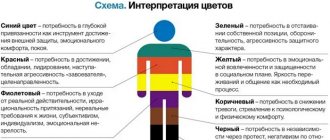Self-esteem is a person’s idea of his capabilities, strengths and weaknesses, personal qualities, abilities, skills, appearance in comparison with others. Self-confidence directly depends on the level of self-esteem - and this is a key point in achieving success.
Self-esteem is formed from childhood - as soon as the child begins to understand himself. He copies the behavior, worldview and self-esteem of his parents. The atmosphere in the family plays an important role. A child who is loved and supported grows up to be self-sufficient and treat himself adequately. But if parents are overprotective or, conversely, dismissive, self-esteem will be low. Subsequently, it increases or decreases depending on the experience gained, relationships with others, or as a result of working on oneself.
We suggest taking a self-esteem test to determine how you perceive yourself and your capabilities.
Self-esteem scale (test by Ch.D. Spielberger - Yu.L. Khanin)
This test is a reliable source of information about a person’s self-assessment of the level of their anxiety at the moment (reactive anxiety) and personal anxiety (as a stable characteristic of a person). Designed by Ch.D. Spielberger (USA) and adapted by Yu.L. Khanin.
Personal anxiety characterizes a stable tendency to perceive a wide range of situations as threatening and to react to such situations with a state of anxiety. Reactive anxiety is characterized by tension, restlessness, and nervousness. Very high reactive anxiety causes disturbances in attention, sometimes disturbances in fine coordination. Very high personal anxiety directly correlates with the presence of neurotic conflict, with emotional and neurotic breakdowns and psychosomatic diseases.
But anxiety is not inherently a negative trait. A certain level of anxiety is a natural and obligatory feature of an active personality. At the same time, there is an optimal individual level of “useful anxiety.”
The self-esteem scale consists of 2 parts, separately assessing reactive (RT, statements No. 1-20) and personal (LT, statements No. 21-40) anxiety.
RT and LT indicators are calculated using the formulas:
When interpreting, the result can be assessed as follows:
up to 30 – low anxiety;
31 — 45 - moderate anxiety;
46 and more - high anxiety.
Significant deviations from the level of moderate anxiety require special attention; high anxiety implies a tendency to manifest a state of anxiety in situations of assessing one’s own competence. In this case, the subjective significance of the situation and tasks should be reduced and the emphasis should be shifted to understanding the activity and creating a sense of confidence in success.
Low anxiety, on the contrary, requires increased attention to the motives of activity and an increased sense of responsibility. But sometimes very low anxiety in test scores is the result of an individual’s active repression of high anxiety in order to show himself “in the best light.”
Instructions:
“Read each of the sentences below carefully and cross out the appropriate number on the right depending on how you feel at the moment. Don’t overthink the questions because there are no right or wrong answers.”
What to pay attention to based on the results of express diagnostics of self-esteem level
Test for the level of self-esteem Photo: Depositphotos
Depending on the results of the express diagnostics of the level of self-esteem, we recommend paying attention to the following points.
Heightened self-esteem
Did the test show that you have high self-esteem? Most likely, you overestimate your strength. In this state, a person sets goals that are obviously difficult to achieve and, if he fails to achieve them, he becomes depressed, apathetic, and blames himself. In addition, people with high self-esteem are distinguished by:
- Constant rivalry;
- The desire to control everything;
- Confidence in one’s rightness, despite the convincing arguments of other people;
- Reluctance to admit your mistakes;
- The fear of appearing weak and insecure is why a person will never ask for help;
- Reassessing your own opinion.
Inflated self-esteem prevents you from adequately assessing circumstances and your capabilities, and therefore greatly complicates the path to your goal. Here are some tips on how to change the situation for the better.
How to correct high self-esteem?
Realize your right to make a mistake, a mistake. This will not humiliate you - on the contrary, it will allow you to gain invaluable experience, draw conclusions, become wiser and more professional. Do not perceive your mistakes as a tragedy - analyze the situation and find the right solutions.
Learn to hear other people and leave them the right to their own opinion. You stand up for yours, so why can’t others? Each person has their own experience, so opinions vary. And if they do not coincide, this does not mean that someone is mistaken - it’s just that your opponent views the situation from a different angle than you see it.
Low self-esteem
If the test result shows you have low self-esteem, this means that your capabilities are much higher than you think. Signs of low self-esteem include:
- Uncertainty;
- Inability to make important decisions;
- Tendency to self-flagellation;
- The desire to please others is why a person often acts to the detriment of his own interests;
- Inability and unwillingness to take responsibility - therefore, people with low self-esteem blame circumstances and others for their failures;
- Dependence on other people's opinions;
- Increased feelings of guilt;
- Negative outlook on life - they look for the bad in everything, concentrate on shortcomings.
Low self-esteem makes a person weak-willed, insecure, and dependent on other people's opinions. And with such qualities it is impossible to grow, set ambitious goals and achieve them. If you recognize yourself, immediately correct the situation.
The fastest and most effective way is to seek help from a psychologist. A specialist will find out the reasons for low self-esteem, help you work through them and change your attitude towards yourself. But you can try to fight on your own. Here are a few techniques that can help you adjust your self-esteem.
How to correct low self-esteem?
Write down your strengths, qualities that you or your loved ones or friends like. Leave false modesty - no one will see this list except you, so don’t be shy to remember each of your virtues. Don’t rush to complete the exercise right away - as you remember, add to the list. Re-read it from time to time - this will allow you to see and realize how many strengths you have. And in the end it will raise self-esteem.
Make a list of activities that bring you pleasure and joy. Start implementing this list into your life - this way you will learn to love yourself and take care of yourself.
List the qualities that you admire and want to cultivate in yourself. Today there is a lot of information on this topic, there is a lot of advice on our website. Use them for self-improvement.
On a separate sheet of paper, write down your desires, goals and start taking steps in this direction. To keep yourself in a resourceful state, play sports. Training will help you stay on a positive wave and energize you.
Celebrate every victory, no matter how small. This way you will see your growth - and along with it, your self-esteem will grow.
An important point: only actions change the situation – just re-reading useful tips will not do. Therefore, start adjusting your self-esteem as soon as possible - the result is worth it!
Material prepared by: Inna Klevacheva Cover photo: Depositphotos
Test No. 2
Instructions. Please indicate how common the conditions listed below are for you on the following scale:
- 4 points - “very often”;
- 3 points – “often”;
- 2 points – “sometimes”;
- 1 point – “rarely”;
- 0 points – “never”.
Control phrases:
- I'm worried for no reason.
- I want to be supported and encouraged.
- I'm afraid of looking stupid.
- I'm worried about my future.
- My friends and colleagues look better than me.
- Many people around me don't understand me.
- I don’t know how to speak beautifully, I’m afraid to have conversations.
- They demand a lot from me.
- I feel squeezed and constrained.
- I feel like something bad might happen to me.
- I worry about what others think of me.
- I feel like people talk about me behind my back.
- I don't feel completely safe.
- I have no one to open my feelings and thoughts to.
- No one is interested in my achievements and successes.
Processing the results. Calculate your final score and check the results table.
| Less than 10 points | 11-30 points | Above 30 points |
| You have a high level of self-esteem. You are confident in yourself, do not need the praise of others and do not care about their opinions of you | You have healthy self-esteem. You are interested in the opinions of others about you, but do not suffer much if it does not coincide with your expectations | Your self-esteem needs repairs. You take criticism and the opinions of loved ones to heart, you are often afraid of the future, doubt your abilities, have a hard time making decisions, and are afraid of new things. |
What symptoms indicate an anxiety disorder?
There are different types of anxiety disorders and each has its own symptoms. But there are a few common ones:
- Panic, fear;
- Insomnia;
- Inability to remain still;
- Chills, tingling hands and feet;
- Dizziness, nausea;
- Dry mouth;
- Cardiopalmus;
- Dyspnea;
- Muscle tension.
If anything from this list is familiar to you, an anxiety test will help you understand at what stage the disorder is.
How to complete this study yourself?
Everything is quite simple. To take the Dembo Rubinstein self-esteem test, take a piece of paper (or a form) and draw four lines vertically. The height of each is clearly 100 mm. Lightly mark the middle of each scale. One point is 1 mm. A checkered sheet is ideal for this.
They will indicate indicators of health, intelligence development (smart), happiness and character. You can also add optimism and general satisfaction with yourself. for teenagers : health, character, intelligence, abilities, beauty, authority among peers, self-confidence (see picture from the Dembo Rubinstein test).
The top of the line is the state of the maximum limit of the indicator (for example, happy, smart, beautiful), the bottom is the minimum value (unhappy, stupid, ugly). . Think and put dashes on the lines where your current state is.
Dembo Rubinstein self-assessment test, student form:
Now, after reflection, draw circles (“o”) where you would like (dream) to be. And finally, the crosses are where you can still be objective if you put in the effort.
If you take a ruler, measure the distances in mm. and write them down. You have received a table where the level of your aspirations is a segment from the very bottom of the scale (zero value) to the crosses. The level of self-esteem is the interval from the bottom of the scale to the dash (-). The discrepancy is the line between the level of your aspirations (cross) and your assessment of yourself (dash).
What is self-esteem
Self-esteem
- this is a person’s level of understanding of himself, his positive and negative qualities, assessment of his personality, part of the self-concept.
Self-perception is inextricably linked to the degree of self-love. The more a person loves himself, the more adequate and higher his self-esteem.
Personal self-esteem is a very significant indicator and influences how a person’s life will turn out. Confidence in your merits, faith in your own strengths allows you to achieve success. On the contrary, humiliation, feelings of guilt and shame, and unjustified shyness prevent internal needs from manifesting and being realized. Basic self-esteem is formed in childhood, but this is a category that can change over time and is subject to correction.
Life story
My cousin is an engineer by profession. But at heart he is a real psychologist! She loves all kinds of psychological tests. He enjoys testing himself and all his family and friends. She had been looking for a long time for a suitable test that would help determine the level of assessment of herself and her personality.
The various tests seemed too complicated and confusing to her. But my sister was completely satisfied with the Dembo Rubinstein test! With its help, she successfully tested not only her family, but also her colleagues.
Many of them, including managers, began to think seriously after receiving the results. I am confident that this analysis helped them embark on the path of personal development and self-improvement.
How to take a self-esteem test
To complete the task:
- Spend 5 – 10 minutes of time.
- Answer questions as honestly as possible, without trying to sound better than you really are. The only person you can deceive in this situation is yourself.
- Don't think too long, trust your first opinion. More often than not, this is the correct one.
Start taking an online psychological test right now and make sure you have a correct idea of your self-esteem.
A few words about the creators of the test
In fact, this Dembo-Rubinstein test is a psychodiagnostic method. It is used for a detailed study of a person’s self-esteem and self-perception. The developer of this technique was Tamara Vulfovna Dembo, a well-known psychologist in the USA, doctor of Clark University and student of Kurt Lewin. T.V. Dembo created this test in 1962.
8 years later, in 1970, it was modified by Susanna Yakovlevna Rubinstein, a famous Soviet psychologist, employee of the pathopsychology laboratory of the Moscow Research Institute of Psychiatry. Interpretation options have been added to the test.
The Dembo-Rubinstein method has been actively used by psychologists and psychotherapists for more than 40 years. With its help, you can diagnose the stability of your attitude towards yourself, the background of your mood, adequacy, maturity, the presence of problems, the level of criticality and demandingness. And also, in general, the level of satisfaction with one’s personality.
Decoding test results
The total score varies from 20 to 80. The test results are divided into four groups.
From 20 to 44 points
This is a normal state without signs of alarm. The person is in a good mood at the time of testing.
From 45 to 59 points
This result indicates mild anxiety or neurotic depression - one that arose due to traumatic events. This could be family troubles, financial problems, dismissal from work, etc. The test subject's mood is noticeably depressed.
From 60 to 74 points
The result indicates a pronounced or severe anxiety disorder. And anxiety is closely related to depression. With such indicators, a subdepressive state or latent depression is diagnosed. It may be invisible to others, but the person is in a bad mood, prone to pessimism, and has decreased performance.
From 75 to 80 points
Extremely severe anxiety disorder. If we are talking about depressive disorder, then the person is in a state of severe depression. At this stage, suicidal tendencies, complete apathy and a serious deterioration in physical health occur.











